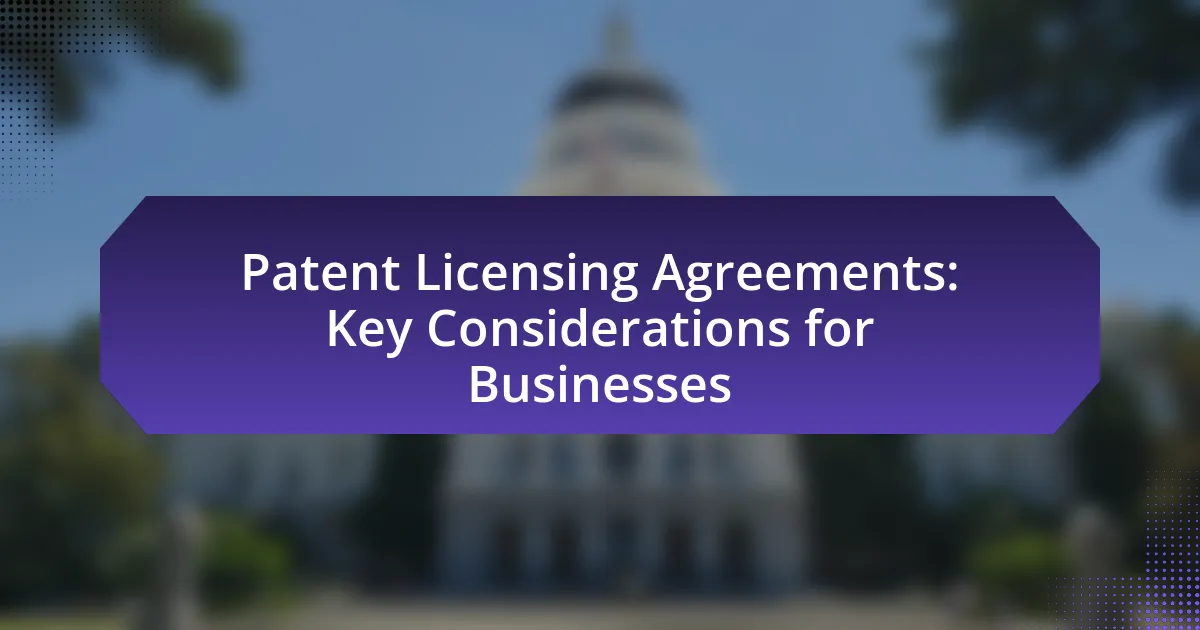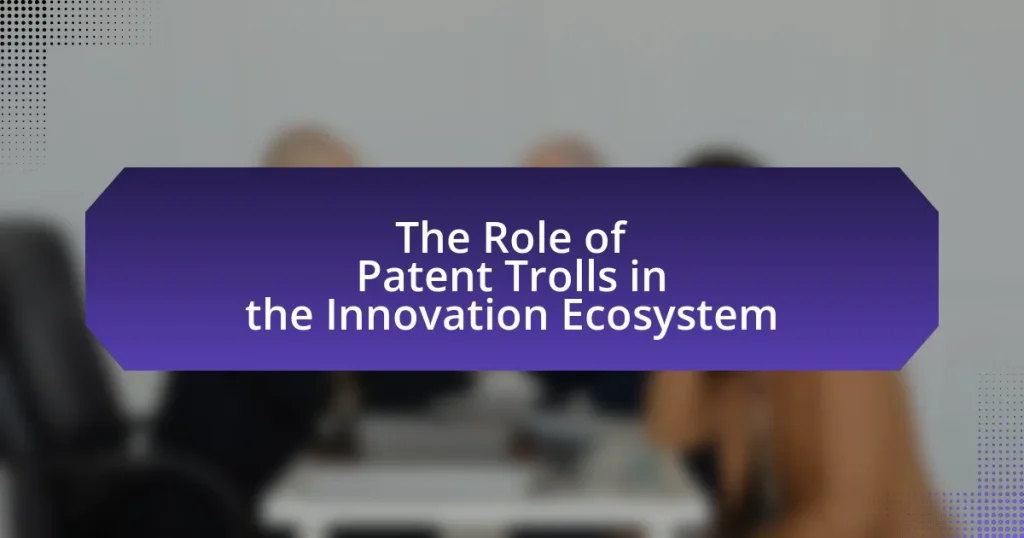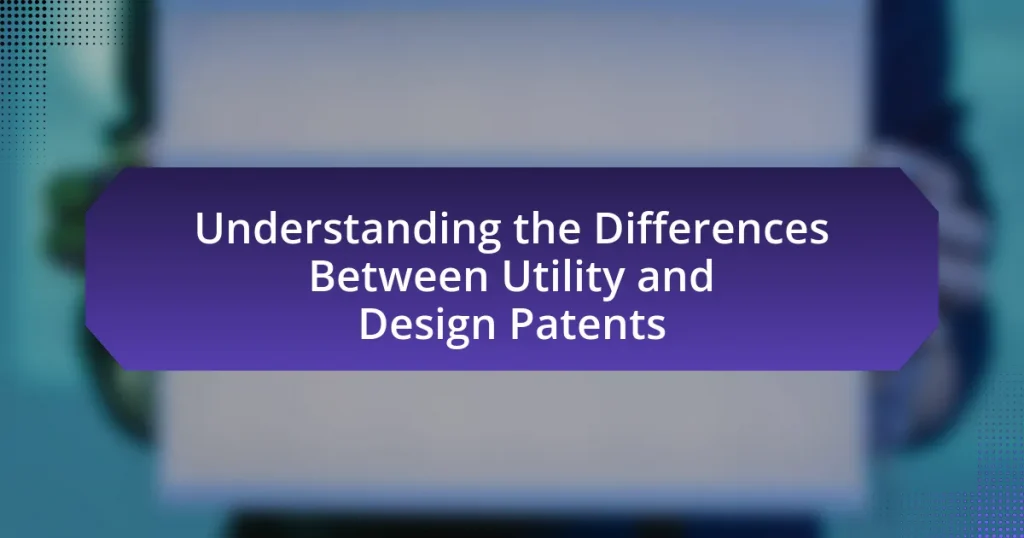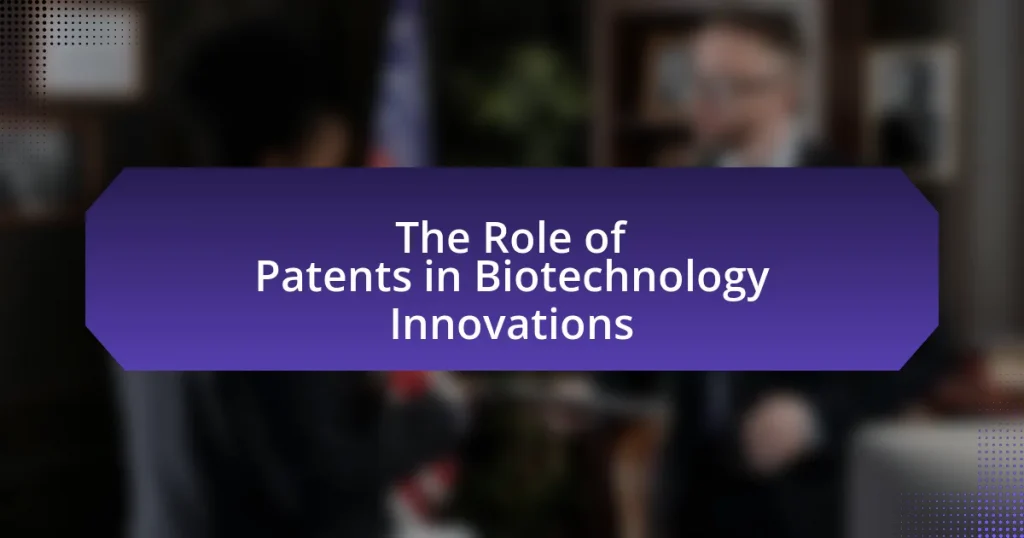Patent licensing agreements are legal contracts that enable one party to use, produce, or sell a patented invention owned by another party in exchange for compensation, typically through royalties. This article outlines the functioning of these agreements, including their key components such as scope, payment terms, and duration, as well as the different types of licenses available, including exclusive and non-exclusive licenses. It also discusses the importance of patent licensing for businesses, highlighting how these agreements can enhance competitive advantage and provide financial benefits. Additionally, the article addresses legal considerations, negotiation strategies, risks, and best practices for managing patent licensing agreements effectively.
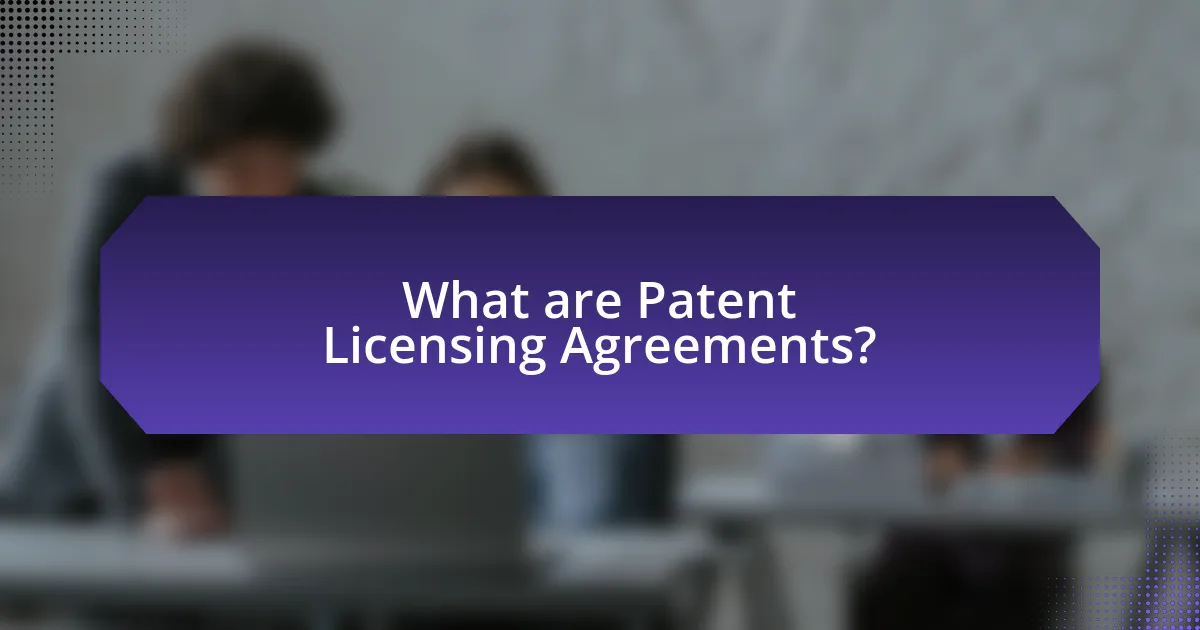
What are Patent Licensing Agreements?
Patent licensing agreements are legal contracts that allow one party to use, produce, or sell a patented invention owned by another party in exchange for compensation, typically in the form of royalties. These agreements define the terms under which the licensee can exploit the patent, including the scope of use, duration, and any limitations or obligations. Patent licensing is a common practice in various industries, enabling innovation and collaboration while providing patent holders with a revenue stream.
How do Patent Licensing Agreements function?
Patent licensing agreements function by allowing a patent holder (licensor) to grant permission to another party (licensee) to use, produce, or sell the patented invention under specified conditions. These agreements typically outline the scope of the license, including geographical limitations, duration, and any financial arrangements such as royalties or lump-sum payments. The licensor retains ownership of the patent while the licensee gains the right to utilize the patented technology, which can facilitate innovation and market entry for the licensee while providing revenue for the licensor.
What are the key components of a Patent Licensing Agreement?
The key components of a Patent Licensing Agreement include the scope of the license, payment terms, duration of the agreement, rights and obligations of both parties, and termination conditions. The scope of the license defines what patents are being licensed and the extent of use permitted. Payment terms outline royalties or fees, including how and when they are to be paid. The duration specifies the time frame for which the license is valid. Rights and obligations detail what each party can and must do under the agreement, while termination conditions explain how and under what circumstances the agreement can be ended. These components are essential for ensuring clarity and legal protection for both the licensor and licensee.
How do these components interact within the agreement?
The components of a patent licensing agreement interact through defined roles and responsibilities that govern the use of intellectual property. The licensor grants rights to the licensee, allowing them to utilize the patented technology under specified terms, such as duration, territory, and payment structures. This interaction is crucial as it establishes the legal framework for how the licensee can exploit the patent while ensuring the licensor receives compensation, typically in the form of royalties. For instance, a study by the World Intellectual Property Organization indicates that clear terms in licensing agreements can enhance collaboration and innovation, demonstrating the importance of these interactions in fostering business relationships.
What types of Patent Licensing Agreements exist?
There are several types of patent licensing agreements, including exclusive licenses, non-exclusive licenses, and sole licenses. Exclusive licenses grant the licensee the sole right to use the patent, preventing the patent holder from licensing it to others. Non-exclusive licenses allow multiple licensees to use the patent simultaneously, while sole licenses permit only one licensee to use the patent, but the patent holder retains the right to use it as well. These distinctions are crucial for businesses to understand as they navigate patent strategies and negotiations.
What is the difference between exclusive and non-exclusive licenses?
Exclusive licenses grant the licensee sole rights to use, produce, or sell the licensed material, meaning the licensor cannot grant these rights to anyone else. In contrast, non-exclusive licenses allow multiple licensees to use the same material simultaneously, enabling the licensor to grant similar rights to various parties. This distinction is crucial in patent licensing agreements, as exclusive licenses often command higher fees due to the limited competition, while non-exclusive licenses can generate broader revenue streams for the licensor by allowing multiple parties to access the same technology.
How do cross-licensing agreements work?
Cross-licensing agreements work by allowing two or more parties to grant each other rights to use their respective patents or technologies. In this arrangement, each party can leverage the other’s intellectual property without the risk of infringement claims, facilitating collaboration and innovation. For example, in the technology sector, companies often enter cross-licensing agreements to share patents related to software or hardware, enabling them to develop products that incorporate features from both parties’ technologies. This practice not only reduces litigation costs but also accelerates product development and market entry, as evidenced by numerous partnerships in the tech industry, such as those between major smartphone manufacturers.
Why are Patent Licensing Agreements important for businesses?
Patent licensing agreements are important for businesses because they enable companies to legally utilize patented technologies, thereby fostering innovation and competitive advantage. By entering into these agreements, businesses can access advanced technologies without the need for extensive research and development, which can be costly and time-consuming. Furthermore, patent licensing can generate revenue streams through royalties, allowing patent holders to monetize their inventions while providing licensees with the opportunity to enhance their product offerings. According to the World Intellectual Property Organization, licensing agreements can significantly boost market entry and expansion, as they allow businesses to leverage existing patents to accelerate growth and improve market positioning.
How can Patent Licensing Agreements enhance competitive advantage?
Patent licensing agreements enhance competitive advantage by allowing businesses to leverage patented technologies without the need for extensive research and development investments. By acquiring licenses, companies can access innovative solutions that improve their product offerings, reduce time to market, and increase operational efficiency. For instance, a study by the National Bureau of Economic Research found that firms engaging in patent licensing can experience a 20% increase in productivity due to enhanced technological capabilities. This strategic use of intellectual property enables businesses to differentiate themselves in the marketplace, respond swiftly to consumer demands, and ultimately gain a stronger market position.
What financial benefits do businesses gain from Patent Licensing Agreements?
Businesses gain significant financial benefits from Patent Licensing Agreements, primarily through revenue generation and cost savings. By licensing patents, companies can earn royalties from other businesses that wish to use their patented technology, creating a steady income stream. For instance, in 2020, the global patent licensing market was valued at approximately $180 billion, highlighting the lucrative nature of such agreements. Additionally, businesses can reduce research and development costs by leveraging existing patents instead of investing in new innovations, allowing them to allocate resources more efficiently. This dual advantage of income generation and cost reduction underscores the financial viability of Patent Licensing Agreements for businesses.

What key considerations should businesses keep in mind when entering Patent Licensing Agreements?
Businesses should consider the scope of the patent, including the specific rights being licensed, when entering Patent Licensing Agreements. This involves clearly defining the territory, duration, and exclusivity of the license to avoid potential disputes. Additionally, businesses must assess the financial terms, such as royalties and upfront payments, ensuring they align with the value of the patent and market conditions. Legal compliance is crucial, as businesses should verify that the patent is valid and enforceable, and that the licensing agreement adheres to relevant laws and regulations. Furthermore, businesses should evaluate the potential for future innovations and how the agreement may impact their ability to develop new products. Lastly, conducting due diligence on the licensor’s reputation and the patent’s market potential can mitigate risks associated with the agreement.
What legal aspects must be addressed in a Patent Licensing Agreement?
A Patent Licensing Agreement must address several legal aspects, including the scope of the license, payment terms, duration, and termination conditions. The scope defines the rights granted to the licensee, specifying whether the license is exclusive or non-exclusive and the geographical areas covered. Payment terms outline royalties or fees, including how they are calculated and when they are due. Duration specifies the time frame for the license, while termination conditions detail the circumstances under which the agreement can be ended by either party. These elements are crucial to ensure clarity and enforceability, as evidenced by legal precedents that highlight disputes arising from vague agreements.
How do jurisdiction and governing law affect the agreement?
Jurisdiction and governing law significantly influence the enforceability and interpretation of a patent licensing agreement. Jurisdiction determines which court has the authority to resolve disputes arising from the agreement, while governing law specifies the legal framework that will be applied to interpret the terms of the agreement. For instance, if a patent licensing agreement stipulates that disputes will be resolved in a specific state or country, that jurisdiction will dictate the procedural rules and legal standards applicable to any litigation. Additionally, the governing law can affect the rights and obligations of the parties involved, as different jurisdictions may have varying laws regarding patent rights, licensing terms, and remedies for breach. Therefore, the choice of jurisdiction and governing law is crucial, as it can impact the outcome of legal disputes and the overall effectiveness of the agreement.
What are the implications of patent validity and enforceability?
Patent validity and enforceability directly impact a business’s ability to protect its innovations and maintain competitive advantage. Valid patents provide legal rights that prevent others from making, using, or selling the patented invention without permission, thereby enabling the patent holder to monetize their invention through licensing or sales. Enforceability ensures that these rights can be upheld in a court of law, allowing patent holders to seek remedies against infringers. For instance, a study by the United States Patent and Trademark Office indicates that patents that are successfully enforced can lead to increased investment in research and development, as companies feel more secure in their intellectual property rights. Thus, the implications of patent validity and enforceability are significant, influencing business strategies, investment decisions, and market dynamics.
What negotiation strategies are effective for Patent Licensing Agreements?
Effective negotiation strategies for Patent Licensing Agreements include thorough preparation, clear communication, and establishing mutual benefits. Preparation involves understanding the patent’s value, market conditions, and potential licensing partners, which allows for informed decision-making. Clear communication ensures that both parties articulate their needs and expectations, fostering a collaborative environment. Establishing mutual benefits focuses on creating win-win scenarios, where both the patent holder and the licensee see value in the agreement, enhancing the likelihood of a successful negotiation. These strategies are supported by industry practices that emphasize the importance of relationship-building and transparency in negotiations, leading to more sustainable agreements.
How can businesses determine fair royalty rates?
Businesses can determine fair royalty rates by analyzing market conditions, comparable licensing agreements, and the value of the intellectual property involved. Market analysis involves assessing industry standards and trends, which can provide a benchmark for setting rates. Additionally, examining similar licensing agreements helps businesses understand what rates are typically accepted within their sector. The value of the intellectual property can be evaluated based on its uniqueness, the competitive advantage it provides, and potential revenue generation, ensuring that the royalty rate reflects the true worth of the asset.
What terms should be prioritized during negotiations?
The terms that should be prioritized during negotiations for patent licensing agreements include scope of the license, royalty rates, duration of the agreement, and rights to sublicense. The scope of the license defines the specific patents and territories covered, which is crucial for both parties to understand their rights and limitations. Royalty rates determine the financial compensation for the use of the patent, impacting the profitability for the patent holder and the cost for the licensee. The duration of the agreement establishes how long the license is valid, which can affect long-term business strategies. Rights to sublicense allow the licensee to grant permissions to third parties, potentially expanding market reach and revenue opportunities. Prioritizing these terms ensures clarity and alignment of interests between the negotiating parties, ultimately leading to a more effective agreement.
What risks are associated with Patent Licensing Agreements?
Patent licensing agreements carry several risks, including potential infringement disputes, financial instability, and loss of control over intellectual property. Infringement disputes can arise if the licensee uses the patented technology in ways not covered by the agreement, leading to costly legal battles. Financial instability may occur if the licensee fails to meet royalty payments or if market conditions change, impacting the profitability of the licensed product. Additionally, licensors may lose control over how their patents are used, which can dilute brand value or lead to misuse of the technology. These risks highlight the importance of carefully drafting and negotiating patent licensing agreements to mitigate potential issues.
How can businesses mitigate potential infringement issues?
Businesses can mitigate potential infringement issues by conducting thorough patent searches and obtaining legal opinions on their products or services. This proactive approach helps identify existing patents that may pose risks, allowing businesses to adjust their offerings or seek licenses. According to the United States Patent and Trademark Office, conducting a comprehensive patent search can reduce the likelihood of unintentional infringement, as it provides insight into existing intellectual property rights. Additionally, businesses should implement robust training programs for employees on intellectual property laws and best practices, which can further minimize the risk of infringement.
What are the consequences of non-compliance with licensing terms?
Non-compliance with licensing terms can lead to significant legal and financial consequences for businesses. These consequences may include monetary damages, which can be substantial, as well as the potential for injunctions that prevent further use of the licensed material. Additionally, non-compliance may result in the termination of the licensing agreement, leading to loss of access to critical intellectual property. Legal actions taken by the licensor can also incur further costs and damage the business’s reputation. According to the American Bar Association, breaches of licensing agreements often result in litigation, which can be both time-consuming and costly, emphasizing the importance of adhering to licensing terms.
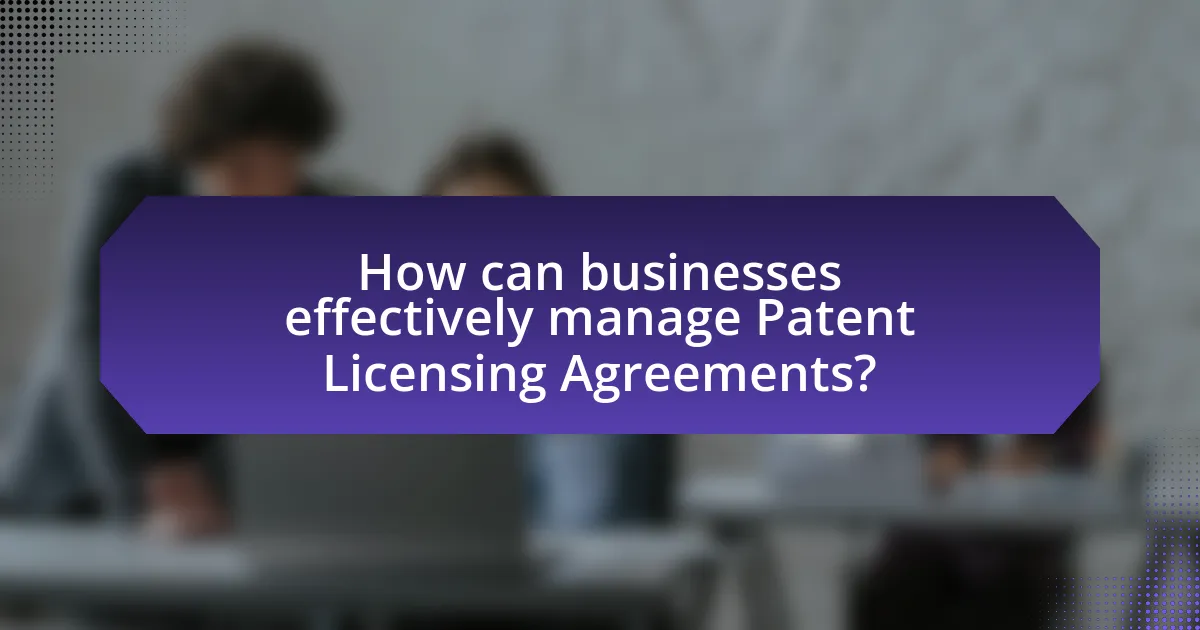
How can businesses effectively manage Patent Licensing Agreements?
Businesses can effectively manage Patent Licensing Agreements by establishing clear terms, maintaining open communication, and regularly reviewing compliance. Clear terms ensure that both parties understand their rights and obligations, which minimizes disputes. Open communication fosters a collaborative relationship, allowing for timely resolution of issues. Regular compliance reviews help identify any deviations from the agreement, ensuring that both parties adhere to the terms. According to a study by the World Intellectual Property Organization, effective management of licensing agreements can lead to increased revenue and reduced legal risks, highlighting the importance of these practices in maximizing the benefits of patent licensing.
What best practices should be followed for ongoing management?
Best practices for ongoing management of patent licensing agreements include regular monitoring of compliance, maintaining open communication with licensees, and conducting periodic reviews of the agreement terms. Regular compliance checks ensure that both parties adhere to the agreed-upon terms, which is crucial for avoiding disputes. Open communication fosters a collaborative relationship, allowing for timely resolution of issues and adjustments to the agreement as necessary. Periodic reviews help assess the agreement’s effectiveness and relevance, ensuring it aligns with current business objectives and market conditions. These practices are supported by industry standards that emphasize the importance of proactive management in maintaining successful licensing relationships.
How can businesses track compliance with licensing terms?
Businesses can track compliance with licensing terms by implementing a combination of software tools, regular audits, and clear documentation processes. Utilizing license management software allows businesses to monitor usage, expiration dates, and compliance metrics in real-time. Regular audits help identify any discrepancies between actual usage and licensing agreements, ensuring adherence to terms. Additionally, maintaining thorough documentation of all licensing agreements and communications provides a reference point for compliance verification. According to a study by the International Licensing Industry Merchandisers’ Association, companies that actively manage their licensing agreements report a 30% reduction in compliance-related issues.
What tools can assist in managing Patent Licensing Agreements?
Tools that can assist in managing Patent Licensing Agreements include specialized software platforms such as IP management systems, contract lifecycle management tools, and database solutions for tracking licensing terms. These tools streamline the administration of agreements, ensuring compliance and facilitating communication between parties. For instance, software like CPA Global and Anaqua provides features for monitoring deadlines, managing royalties, and generating reports, which enhances the efficiency of managing patent portfolios. Additionally, tools like DocuSign enable secure electronic signatures, expediting the agreement process.
What common pitfalls should businesses avoid in Patent Licensing Agreements?
Businesses should avoid vague terms and conditions in Patent Licensing Agreements, as ambiguity can lead to disputes and misinterpretations. Clear definitions of rights, obligations, and scope of use are essential to prevent conflicts. Additionally, failing to conduct thorough due diligence on the patent’s validity and enforceability can result in licensing agreements based on flawed assumptions, potentially leading to financial losses. Another common pitfall is neglecting to include proper termination clauses, which can leave businesses vulnerable if the agreement needs to be dissolved. Lastly, overlooking the importance of compliance with relevant laws and regulations can expose businesses to legal risks and penalties.
How can unclear terms lead to disputes?
Unclear terms in patent licensing agreements can lead to disputes by creating ambiguity regarding the rights and obligations of the parties involved. When terms are not clearly defined, such as scope of use, payment structures, or duration of the license, it can result in differing interpretations by the parties. For instance, a study by the American Bar Association highlights that vague language in contracts is a common source of litigation, as parties may have conflicting understandings of their agreements. This ambiguity can lead to disagreements over what constitutes a breach, the extent of rights granted, or the responsibilities of each party, ultimately resulting in legal disputes.
What are the dangers of overlooking renewal and termination clauses?
Overlooking renewal and termination clauses can lead to significant legal and financial risks for businesses. Without clear terms, a company may inadvertently continue a licensing agreement beyond its intended duration, resulting in ongoing obligations and potential liabilities. Additionally, failing to terminate an agreement when necessary can prevent a business from pursuing more favorable opportunities or negotiating better terms, ultimately hindering growth and competitiveness. Furthermore, unclear clauses can lead to disputes, which may result in costly litigation or damage to business relationships.
What practical tips can businesses implement for successful Patent Licensing Agreements?
Businesses can implement several practical tips for successful Patent Licensing Agreements, including conducting thorough due diligence, clearly defining the scope of the license, and establishing clear terms for royalties and payment structures. Conducting due diligence ensures that businesses understand the patent’s validity and market potential, which is crucial for informed negotiations. Clearly defining the scope of the license helps prevent disputes by specifying the rights granted, such as geographic limitations and field of use. Establishing clear terms for royalties and payment structures, including upfront fees and ongoing royalties, provides financial clarity and aligns expectations between parties. These practices are supported by industry standards and successful case studies, demonstrating their effectiveness in fostering mutually beneficial agreements.
